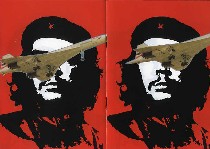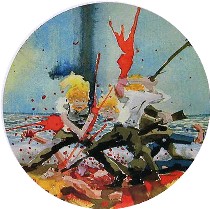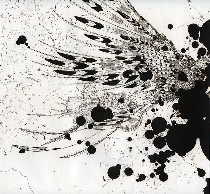
I bought the catalog for the Whitney Biennial. It weighs 7.5 pounds. So if you’re going out for a night on the town, carrying your catalog with you, you’ll need a little grocery cart for schlepping.
On the other hand, the reason it weighed so much had to do with advertising specialties and artist treats–stickers, photographic transparencies, artists booklets (shown above, Aleksandra Mir’s “Che and Concorde” booklet, a series of stills that might have made a nice flip book), large artist pages folded like a book, postcards, even advertisements and a lottery drawing entry form.

All of these treasures were stuffed into a box accompanying the catalog.
The catalog has a luxe flocked hard cover. The box has plain paper cover. Both are in a subdued gray with silver lettering. I love this stuff.
My only complaint other than the weight (It’s not heavy, it’s art work) is that some of the boxed items lacked signatures or id numbers (every artist in this show has an id number), or perhaps they were so subtle, I couldn’t find them (you can see on Virgil Marti’s booklet back cover, with the sexy chandelier detail shown above, that he’s number 60).

I don’t know if not identifying themselves in their bit of extra-museum territory is a form of arrogance (an assumption that you’d recognize the work as theirs) or a form of modesty (can you find the 32 on Barnaby Furnas’s round sticker, shown? It took me a while.), or, most likely of all, a product of this computer age, in which we can download and reproduce with such ease, the sense of ownership less of an issue than in the past.

Otherwise, this is like an ancillary art show that you get to take home with you–tres Duchamp. It sort of reminded me of the Space 1026 catalog from last year, more or less a scrapbook of original prints and images from member artists, loose-leaf bound together (with hardware from the hardware store) so the buyer can deconstruct it and hang or frame the favorites (shown, a bumper sticker from Yutaka Sone, whose marble highway junctions amidst a jungle installation on the first floor of the Whitney were not nearly as loopy).

So now I have my memories of what I saw, the catalog images of what I saw, and these paper extras, in some cases reproductions of what I saw, in other cases something else entirely (shown, detail from Ernesto Caivano’s unfolded image, which like all of them, is 22 1/2 inches long).









